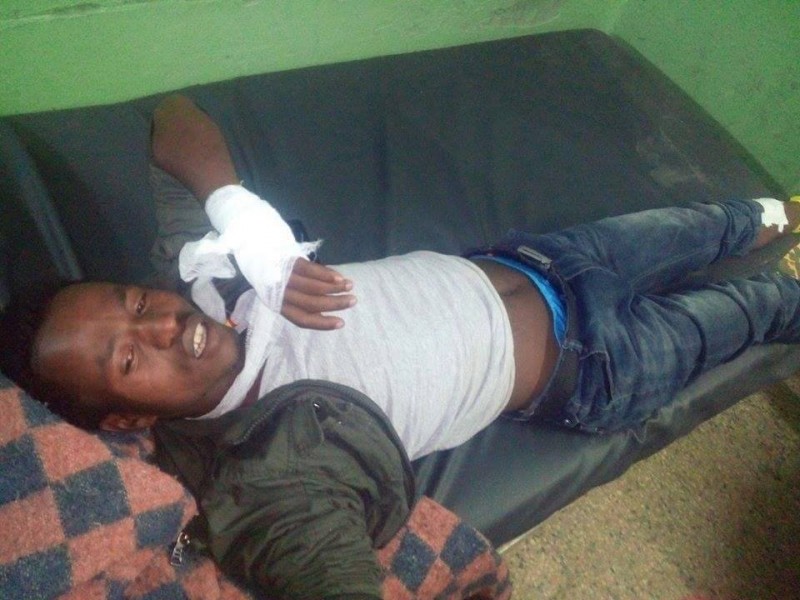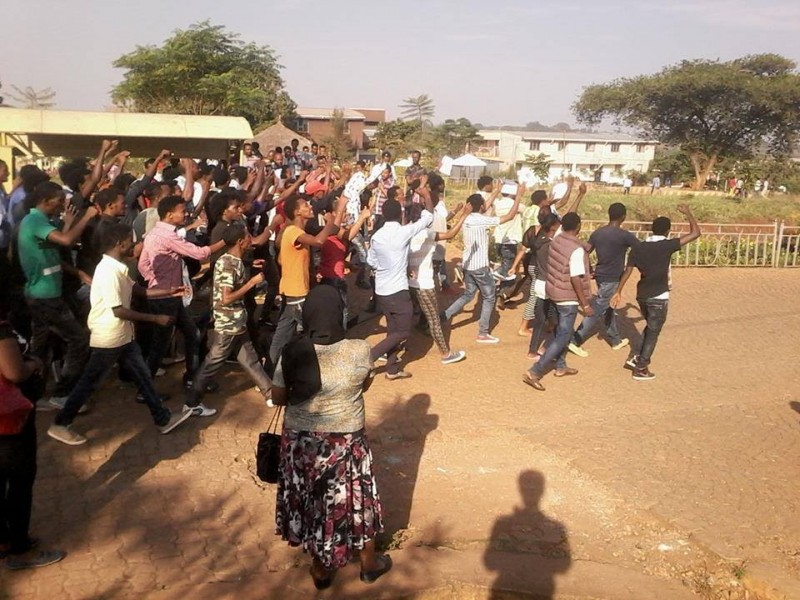
Students mourning at Haromaya University. Photo shared widely on social media.
Since student protests erupted in Ethiopia last November, numerous mobile phone videos have gone viral on social media, giving a glimpse of the government's brutal and deadly crackdown on demonstrators.
Students in Oromia, Ethiopia’s largest regional state, have been demonstrating against the government's so-called developmental “Master Plan” to expand the area of the capital, Addis Ababa, into Oromia. Students and other citizens, along with many Ethiopians living abroad, believe the move will result in direct persecution of the Oromo ethnic group, which has been systematically marginalized by the government over the last two decades, despite representing Ethiopia's largest ethnic group.
…over the last few days, a picture showing a police officer standing beside a dead body hanging from a tree has been circulating on Facebook. There is no caption or explanation attached to the photo.
Reports indicate that security forces are using violence, including live ammunition, to disperse crowds of peaceful demonstrators at universities in Oromia. According to Human Rights Watch, at least 75 people have been killed by Ethiopian security forces since the protests began. The Horn of Africa Human Rights Council is reporting slightly higher numbers and estimated a death toll of 122 on December 28, 2015.
Although less than four percent of Ethiopians have access to the Internet, activists in the country are using online platforms as a means of articulating protests, networking and presenting news for international readership. Advocates both in and outside of the country upload these videos, usually on their Facebook pages, to show what the Ethiopian government is attempting to hide.
Given the scarcity of reporting by professional photojournalists or correspondents based in Ethiopia, these videos are filling a critical void. But the majority of the images lack necessary context.
Protester videos: From the street to the screen
A little over 200 videos have been uploaded on different online platforms since the first round of Oromo protests that began around April of 2014. The videos run from seconds to three minutes. The vast majority of them are shot on low-quality mobile phone cameras, and they usually appear out of focus and shaky. Most of the videos show peaceful demonstrations with the protesters holding their arms crossed in the air, chanting slogans of solidarity in the Oromo language. Other videos and pictures show instances of police beatings, use of live ammunition on protesters, and dead and injured people.

Photo published on EthioTube page titled “Pictures from Oromo Protest – Winter 2015″. No attribution or further context for the photo appears on the site.
Most of these materials are initially shared on the Facebook pages of prominentactivists. They are routinely rebroadcasted into Ethiopia via diaspora based satellite TV channels ESAT and OMN. They are also frequently uploaded on Ethiopian online platforms such as EthioTube, a video platform run by Ethiopians living abroad. Most of the materials are too gruesome to be shown here. For instance, over the last few days, a picture showing a police officer standing beside a dead body hanging from a tree has been circulating on Facebook. There is no caption or explanation attached to the photo.
Most videos that show police beatings and torture have been captured from a distance. Presumably, those taking footage are attempting to avoid being caught or captured by authorities. This limits the efficacy of the video as evidence — even though the materials show human rights violations, most of the time they do not tell individualized stories that could offer more insight into the ongoing protests.
It also points to critical questions about state monitoring of demonstrators. Anonymity is essential for demonstrators, as government forces are actively searching for dissidents. Although there is significant awareness of this issue among students, many citizen journalists have been publishing their materials online without erasing the easily identifiable metadata and other information on the videos.
‘The government should arrest people who press the ‘like’ button’
In order discredit these messages and other online content, the Ethiopian government has launched a powerful propaganda campaign against the use of the social media. Over the last two weeks, state-owned media organizations broadcasted multiple television and radio programs about how the Internet, and social media in particular, is being used by so-called “forces of harm” to instigate violence and tarnish the image of the country.
On the weekly state television program, “Overview of the Media“, host Fetehawek and pro-government commentators Dawit Kebede and Tadesse Mizane discussed the role of social media in Oromo student protests.
‘‘In relation to the recent Oromo protest some diaspora-based activists are spreading fake images of protests and human atrocities on social media to make it look like it has happened in Ethiopia,” Fetehawek said. He then showed a series of dubious images — some appeared doctored, others looked altogether fake — that the activists allegedly shared on Facebook. He went on to suggest that all materials about Oromo Protest on Facebook are false.
It may be that some protesters have shared fake images on social media. But the volume of images being shared along with corroboration from sources in the country suggests that the many of them are real.

Photo published on EthioTube page titled “Pictures from Oromo Protest – Winter 2015″. No attribution or further context appears on the site.
The program continued with pundit Tadesse Mizane noting that “leading Republican presidential candidate Mr. Donald Trump suggested that closing sections of the Internet is a solution for this.” Dawit Kebede, a producer of Awaramba Times, took this line of thinking even further, arguing that the “Government should arrest people who press the ‘like’ button or ‘share’ such materials.”
Confronting ethical challenges
The ubiquity of these decontextualized raw images and videos makes it difficult for viewers to see the bigger picture. There are complex stories behind the images, as well as legal implications of using the images against the perpetrators, concerns for victims’ privacy and for the safety of the citizens who are recording the protest using their phones.
Although many of these stories can only be told by the people who are capturing these images and their subjects, various NGOs and Internet companies offer ways to seek further information about these digital files using online tools (see guides fromAmnesty International and WITNESS.) There are also simple steps that eye witness reporters can take in order to make a video easy to verify. Including a recognizable landmark in an image or video (this could be anything from a building to a street sign) can help verify the location of the footage. Showing a current newspaper with the date clearly displayed can help verify the date it was captured.
Source: globalvoices.org
No comments:
Post a Comment